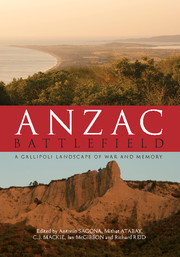Book contents
- Frontmatter
- Foreword
- Contents
- Figures
- Plates
- Contributors
- Acknowledgements
- Abbreviations
- Gallipoli battlefield place names
- Introduction
- 1 Boundary and divide: The antiquity of the Dardanelles
- 2 The Gallipoli campaign: History and legend
- 3 Recording the battlefield: First steps
- 4 Capturing the battlefield: Mapping and air photography at Gallipoli
- 5 Battlefield archaeology: Gallipoli
- 6 Forming the ANZAC battlefield
- 7 Forming the Ottoman battlefield
- 8 Artefacts from the battlefield
- 9 Remembering Gallipoli
- 10 Remembering Gallipoli from a Turkish perspective
- Conclusion
- Appendix Anzac Gallipoli Archaeological Database
- References
- Index
7 - Forming the Ottoman battlefield
Published online by Cambridge University Press: 05 December 2015
- Frontmatter
- Foreword
- Contents
- Figures
- Plates
- Contributors
- Acknowledgements
- Abbreviations
- Gallipoli battlefield place names
- Introduction
- 1 Boundary and divide: The antiquity of the Dardanelles
- 2 The Gallipoli campaign: History and legend
- 3 Recording the battlefield: First steps
- 4 Capturing the battlefield: Mapping and air photography at Gallipoli
- 5 Battlefield archaeology: Gallipoli
- 6 Forming the ANZAC battlefield
- 7 Forming the Ottoman battlefield
- 8 Artefacts from the battlefield
- 9 Remembering Gallipoli
- 10 Remembering Gallipoli from a Turkish perspective
- Conclusion
- Appendix Anzac Gallipoli Archaeological Database
- References
- Index
Summary
Turkish measures to defend the Gallipoli Peninsula and the strategy that was implemented to counter a likely landing operation were above all influenced by the peninsula's physical features. It was necessary to reshape the battlefield from the outset. Troops were deployed according to the likely landing locations. Trenches, artillery, machine gun nests, communication lines, rear-guard connections and other requirements were arranged and shaped according to the topography. Some field works, such as trenches, artillery sites and access routes in the Arı Burnu area, had already been constructed during the Balkan Wars. These were improved and extended after the likelihood of another war emerged. When preparing the area for war in 1915, the Turks were able to take into account advantages the Arı Burnu geography had offered during previous deployments of soldiers there. In that regard, they had the advantage over the Anzac soldiers who would land in the area.
Arı Burnu consists of two capes, namely north and south Arı Burnu, and the slopes of Kocaçimen Tepe (Hill 971), with ridges running parallel to the coast towards Gaba Tepe in the south. Arı Burnu was considered an important location within the Gaba Tepe landing zone. The coast near Gaba Tepe was the most appropriate location for landing the heaviest war vehicles, providing an obstacle-free disembarkation point and route. The Anzacs’ initial objective was to seize and hold Artillery Ridge (Topçular Sırtı) from Hill 971 to Gaba Tepe. But it was necessary to hold Arı Burnu, a natural fortification that dominated the Gaba Tepe coast and plain, to ensure safe landings. While Gaba Tepe was suitable for a landing, the Arı Burnu coast was steep and rugged, and inappropriate for disembarking, then operating heavy vehicles. It was impossible to land soldiers on the Gaba Tepe coast without first securing the Arı Burnu area. Prominent and effective natural defences dominated the land up to the strait and the sea. The Nara Cape and Mecidiye and Hamidiye strongholds were among the strategic locations that enabled long-range artillery (firing to 9000–13 000m) to enfilade the coastal area from the flanks and rear.
The deployment sites were on Conkbayırı Hill in the foothills of Kocaçimen Tepe and at points on the ridge that extends from Conkbayırı (Chunuk Bair) to Gaba Tepe, including Suyatağı, Kemalyeri, Göktepe and Kavaktepe.
- Type
- Chapter
- Information
- Anzac BattlefieldA Gallipoli Landscape of War and Memory, pp. 138 - 158Publisher: Cambridge University PressPrint publication year: 2016



